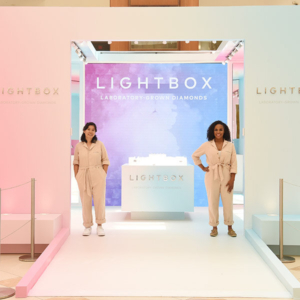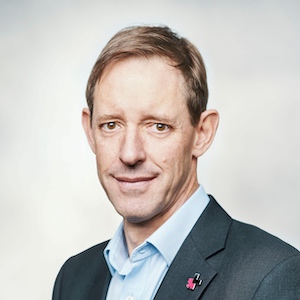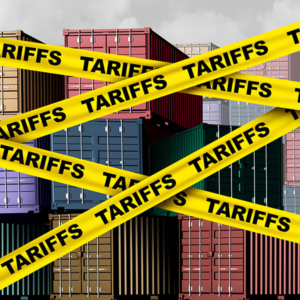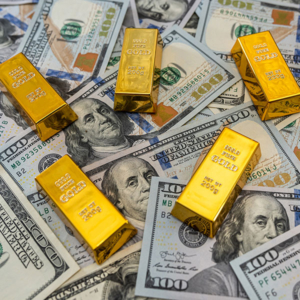
In part 2 of our exit interview with De Beers CEO Bruce Cleaver, he reviews the big events of his tenure, from Nirav Modi’s implosion to the COVID-19 pandemic to De Beers’ still-controversial introduction of lab-grown brand Lightbox.
Let’s go back to 2016, when you became CEO. Before that, there was a certain breakdown in relations between De Beers and its clients. Early on, you said that was something you wanted to rebuild.
It’s one of the things that I’m pleased about from my time here. I think our relationships with our customers, and all of our stakeholders, are in a much better place than they were in 2016.
2018 started off with the Nirav Modi scandal, and a lot of people thought that hurt the industry with the banks, and helped push it into crisis. Any reflections on that?
My biggest reflection on that is: However much work you do toward planning for the future, there are things in the diamond industry that you just can’t predict. Also, demonetization just appeared out of the blue in India one day.
We have risk registers at De Beers, where we pore over all the risks we can think of, and we assign people to think about how to deal with them if they happen. Of course, pandemic was not on that list, nor was Mr. Modi, nor was a war in Ukraine.
These are things we couldn’t have anticipated, which require you to change course as a business and spend a lot of time talking to key stakeholders. If you spoke to me in 2016, I would have underestimated how these things could happen and how much time they would take and how much work they require. We live in a world that is so volatile and so subject to change. That’s a lesson for all businesses in the diamond world. You have to be ready, and you have to be prepared to be resilient. You have to try and embrace these things, because they do happen.
Speaking of things people didn’t expect: In 2018, De Beers introduced Lightbox, a lab-grown diamond brand. Was that on the drawing board before you took over, and why did you choose that particular time?
That’s a great question. I think of that as one of the highlights of my time. If you take a step back, we always knew at De Beers that it may come to pass that we would launch a gem synthetic business. Because we always have had the capability to produce quality synthetics.
When it came to Lightbox, we had some very complicated strategic discussions about whether it was the right thing to do, and if we are going to do it, when was the right time to do it?
We saw a number of people entering into the lab-grown market that didn’t try and sell them as different kinds of products [than natural diamonds]. We felt that we had the cost capacity, because of our history in the industrial world, to sell laboratory-grown diamonds at what we thought were more appropriate prices—fashion-related prices rather than luxury-related prices. And then we agonized for a long time about how we would do it and when we would do it. We had to make a very significant investment in production.
I went and spoke to the presidents of Botswana, Namibia, South Africa, and Angola to make sure they were comfortable that we launched this business, and they didn’t think we were trying to undermine the natural diamond businesses. When we got around to launching it, we discussed a great deal the right time to do it. We thought that the right time to launch it was probably the JCK show, as that’s when we have the whole industry together. And we worried if we waited another year there would be even more production on the market and certainly more traction for laboratory-grown diamonds being [sold as] the same as natural. We thought it important to create our own offering.
I say to people, it’s one of the scariest things I’ve ever done. If we launched this product too soon, we may legitimize a whole category quicker than we should have. What if it was launched too late, and the genie was out of the bottle? We probably launched it at about the right time. I’ve been surprised there’s been very significant growth in lab-grown production in the last 18 months. But my view is that will accelerate the two markets separating.
Some thought Lightbox’s $800-a-carat price point was an attempt to drive prices down.
Clearly, price was important, and the reason for that was consumers told us that there needed to be a big difference in the prices of fashion items as opposed to luxury items. We felt $800-a-carat set a very important line in the sand, where we could say to consumers that this was not luxury but quality fashion.
But price has been one part of the journey in getting these two markets to separate out. If you just look at the growth in price of natural diamonds over the last three or four years and the decline in pricing in lab-grown—notwithstanding the recent blip in the natural world—the differences are very significant.
Do you think that your entry caused more people to enter the sector?
I don’t really take the view that because we entered the market, other people entered. Maybe it accelerated [some entrances] by a few months. But knowing those people, and I talk to a lot of them, they were going to do it anyway. It was really important that we did it in a way that positioned lab-grown as legitimate but not the same [as naturals]. I agree that 2018 was not the most comfortable moment, but I believe it was the right thing to do.
You’re starting to see people get out of the lab-grown space. And that’s interesting to me, because the margins that lab-grown diamonds enjoyed—at least at retail—will very likely start to decline. This is a natural progression. I always said that it was like flat-screen televisions. When the first ones came out, they were very expensive and weren’t particularly good quality. Now they are fantastically good quality and significantly cheaper.
Diamond growing is moving to India and China. In retrospect, would it have made more sense to set up your factory there than Portland?
It’s a good question. I’m pleased with what we’ve done on producing carbon-neutral, laboratory-grown diamonds and we will get our natural business to [carbon-neutrality] as well. The enormous increase in [lab-grown] production capacity in China and India is not very green, and it’s very hard to see that it will be.
We looked around the world before we chose Oregon. And of course, America being the main market, it helps to be in-market, so to speak.
You said that you wanted the industry to view lab-grown as fashion. Yet, it’s safe to say that the overwhelming majority of lab-growns are sold as bridal.
Bridal has seen more lab-grown participation than I would have anticipated. But you are continuing to see quite significant growth in the natural diamond business. I take from that the bridal sales in lab-grown are not actually cannibalizing natural sales. Those sales are to folks who would have never bought a natural. I am not sure the natural diamond business would continue to grow if every single bridal lab-grown was cannibalizing a natural. I don’t have enough data on it, but the data I have seen on it suggests that there’s less and less cannibalization. We’ll do more research on that this year.
There were reports that when you announced Lightbox, some cutters in India stopped working because they were convinced the industry was done. Did you anticipate that?
I knew it would be a big story, but I didn’t realize how big a story. We weren’t able to spend a lot of time pre-briefing, like we would ordinarily do. We managed to launch it without the news leaking, which is pretty unusual in the diamond business.
In retrospect, we probably could have spent more time with the trade after we announced it, talking them through it. Once we’d said we were entering into the lab-grown market, people probably didn’t listen to everything we said after that, because they’d already jumped to a conclusion. It took people a few days to digest.
Any other thoughts about Lightbox?
What it shows is that De Beers has become much more innovative, much more prepared to take some risk, than it might have been in the past. These were not easy discussions with [majority owner] Anglo American’s board, but they were very open to it and understanding of what we were trying to do.
It’s part of the cultural change we’ve been through at De Beers to get people to think more about innovation and to do things differently and be prepared to take a chance. Not all of these things work, but you have to accept that with innovation. That’s the only way you’re going to grow your business in the 2020s. We have made a lot of progress in that regard.

When COVID hit, how did you deal with it?
I could talk for hours on this. In many senses, it was the best of times and the worst of times.
A lot of the work that we did, particularly the first year and a half of COVID, most of the industry didn’t see because they don’t operate in the mining space. We shut some mines in Botswana, but we kept paying people because we knew that the single most important thing to stay healthy is to have food on your table. We provided all the PCR machines in Botswana and Namibia. We were instrumental in getting vaccines into those countries. We provided all the PPE in those countries.
And we did it in a way where the collaboration between everyone at De Beers and between De Beers and Anglo was the best I’ve ever seen. In a funny sense, when a real crisis comes along, people pull together in a way that’s just extraordinary. And I often think as a management theme: How do you get people to work together like that when they’re not in crisis? Because it’s amazing what people can do in crisis.
To me, the biggest tragedy was governments hoarding vaccinations when other governments couldn’t get their hands on them. In my world, 79 people died from COVID-19: 78 of them in the Southern Hemisphere, most of them under 60, many of them without underlying conditions. And I’ve no doubt if we could have gotten vaccinations to people in the Southern Hemisphere quicker, we would have had less fatalities. In the winter of 2021, I got a call every day about somebody who died from COVID. And many of them I knew personally, and each of them has a story to tell, and it’s a horrifying story.
The example I give is that my then-20-year-old son got three doses of the vaccine before my 85-year-old parents and parents-in-law got any. The only reason is he lived in London, and they live in Cape Town. I’ll never forget that. I understand why governments felt the need to vaccinate their own people first. But I do wonder if there was better coordination between the developed world and the developing world, there would have been far less of a tragedy.
The beginning of COVID was a scary time for the industry.
We were budgeted to sell roughly $1.5 billion in the second quarter of 2020. We sold $57 million. That can keep you awake at night as a chief executive. Fortunately, our balance sheet was much stronger than it was during the 2008 crisis.
The bounce-back in 2021 was incredible. I always thought that we would have a strong bounce-back, but I didn’t expect it to be as strong as it was.
I suppose you have to remember that even in the darkest times, around the corner there’s always good times. The diamond industry is a cyclical business. It’s an industry that, in dark times, likes to talk a great deal about why things are bad. But then they turn, as they always do. And I always say to people, you’ve got to be more calm through the downturns, as well as the upturns, because they both come.
Is there anything else you would like to share?
It’s been quite a ride. It’s been a fascinating time. I think the business is in a better place now than it was seven years ago. We’re in the middle of yet another slightly awkward time, but I have no doubt that with China opening up, you’ll see things come back soon.
I feel unbelievably privileged to have done this job. I did it longer than I thought I would, because it’s a fabulous job, but it is quite an exhausting job. I spent three weeks out of four on the road. I’m very pleased I went on my own terms and was able to be involved in selecting my successor. It’s an amazing industry. One thing about this business, you are never bored.
Top: A Lightbox pop-up store (Photos courtesy of De Beers)
- Subscribe to the JCK News Daily
- Subscribe to the JCK Special Report
- Follow JCK on Instagram: @jckmagazine
- Follow JCK on X: @jckmagazine
- Follow JCK on Facebook: @jckmagazine






